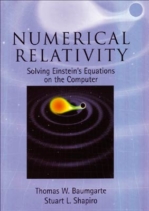By Thomas W Baumgarte and Stuart L Shapiro
Cambridge University Press
Hardback: £55 $90
E-book: $72

Symmetries are a powerful tool for solving specific problems in all areas of physics. However, there are situations where both exact and approximate symmetries are lacking and, therefore, it is necessary to employ numerical methods. This, in essence, is the main motivation invoked for the use of large-scale simulations in relativistic systems where gravity plays a key role, such as black-hole formation, rotating stars, binary neutron-star evolution and even binary black-hole evolution.
Numerical Relativity by Thomas Baumgarte and Stuart Shapiro is an interesting and valuable contribution to the literature on this subject. Both authors are well known in the field. Shapiro, together with Saul Teukolsky, wrote a monograph on a related subject – Black Holes, White Dwarfs and Neutron Stars (John Wiley & Sons 1983) – that is familiar to students and researchers. The careful reader will recognize various similarities in the overall style of the presentation, with systematic attention to the details of the mathematical apparatus. In Numerical Relativity, 18 chapters are supplemented by a rich appendix. The first part could be used by students and practitioners for tutorials on the so-called Adler-Deser-Misner formalism and, ultimately, on the correct formulation of the Cauchy problem in general relativity.
It seems that the authors implicitly suggest that the future of numerical relativity is closely linked to our experimental ability to observe directly general relativistic effects at work. While astrophysics and gravitational waves have so far provided a rich arena for the applications, the intrinsic difficulties in detecting high-frequency gravitational waves with wide-band interferometers, such as LIGO and VIRGO, might suggest new cosmological applications of numerical techniques in the years to come. This book will take you into an exciting world populated by binary neutron stars and binary black holes.
Still, the achievements of numerical relativity (as well as those of all of the other areas of physics where large-scale computer simulations are extensively used) cannot be reduced simply to the quest for the most efficient algorithm. At the end of nearly 700 pages, the reader is led to reflect: is it wise to commit the research programme of young students and post-docs solely to the development of a complex code? After all, the lack of symmetry in a problem might just reflect the inability of physicists to see the right symmetries for the problem. A balanced perspective for potential readers can be summarized in the words of Vicky Weisskopf, when talking about the proliferation of numerical methods in all areas of physics: “[…] We should not be content with computer data. It is important to find more direct insights into what a theory says, even if such insights are insufficient to yield the numerical results obtained by computers” (Joy of Insight: Passions of a Physicist, Basic Books, 1991).





